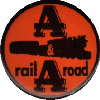Arcade and Attica Railroad
| Arcade and Attica Railroad | |
|---|---|

| |
| Reporting marks | ARA |
| Locale | New York |
| Dates of operation | 1917 – present |
| Track gauge | 4 ft 8½ in (1435 mm) (standard gauge) |
| Headquarters | Arcade, NY |
Incorporated in 1917, the Arcade and Attica Railroad (AAR reporting marks ARA) is a shortline railroad that hauls freight between Arcade, New York and North Java, New York. The railroad originally connected Arcade with Attica, New York, however the right of way north of North Java was abandoned in 1957 due to flooding on the Tonawanda Creek.
The principal business of the ARA is handling agricultural products (soy beans, corn, and fertilizer), lumber, dairy feed, and other commodities between Arcade and North Java. They continue to use their GE 65-ton as primary freight power, and sometimes will double-head it with the GE 44-ton if they need to move more than 4 cars at once. Days of freight operation remain Monday, Wednesday, Friday, starting its day at 7:00am at the Arcade engine shop. From there, they will run up to the Norfolk Southern interchange, and then out to serve the handful of customers left on the line.
The ARA also runs their ever popular steam excursion passenger trains from May to October, Friday, Saturday, and Sunday. Passengers get to enjoy a 14 mile ride from Arcade to Curriers, New York and back on restored 1920s era Boonton passenger coaches, and an open gondola, pulled by one of their historic steam or early diesel engines.
History
The Arcade and Attica Railroad is the latest in a long succession of railroads planned and built through the Tonawanda Valley in Wyoming County.
In 1836 the Attica and Sheldon Railroad was proposed, but no construction was even begun.
In 1852 the Attica and Alleghany Valley Railroad was incorporated to build a 3 ft (914 mm) narrow gauge line from Attica, through Arcade, to the Pennsylvania state line. in 1853 the contract was let for construction and most of the road was graded between Attica and Arcade. In 1855 construction was discontinued and the property was sold at forclosure on February 2, 1856.
On February 28, 1870 the Attica and Arcade Railroad was organized and began purchasing the right of way with construction of the line scheduled to be complete by October 1, 1876. The railroad went bankrupt in 1873 without ever completing the railroad.
On April 5, 1880 the Tonawanda Valley Railroad was incorporated with major financial backing from the Erie Railroad. The company planned to build a 24 mile, narrow gauge line from Attica, through Curriers Corners, to Sardinia to connect with the Buffalo, New York, and Pennsylvania Railroad. On September 11, 1880 the first train ran on the line from Attica to Curriers Corners. In October 1880 the Tonawanda Valley Extension Railroad was organized to extend the line from Curriers to Sardinia. By that winter the company changed its mind and began building to Arcade, rather than Sardinia. By May 1, 1881 the line had reached Arcade. On July 14, 1881 the Tonawanda Valley and Cuba Railroad was formed to extend the line from Arcade to Cuba via Sandusky and Rushford. On August 27, 1881 the Tonawanda Valley Railroad, Tonawanda Valley Extension Railroad, and Tonawanda Valley and Cuba were merged into the new Tonawanda Valley and Cuba Railroad. By September 4, 1882 the line was complete between Attica and Cuba. The Company built facilities to transfer to the standard-gauge Erie Railroad in Attica and Cuba. In Cuba, the company made a connection with the Bradford, Eldred and Cuba, another narrow-gauge railroad controlled by the Erie. By September 1884 the company was defaulting on its bonds and November 29 the company was in receivership. The company's fortunes further fell when the Bradford, Eldred and Cuba went bankrupt. The company limped along but on October 30, 1886 it stopped service from Cuba to Sandusky. On January 19, 1891 the section from Attica to Freedom was sold to bondholders and in May of that year the Attica and Freedom Railroad was formed. The line went bankrupt and was sold in April 1894.
On October 13, 1894 the Buffalo, Attica and Arcade Railroad was formed to operate the line. The new management switched the line to standard gauge and by January 1895 the Attica to Curriers section was operating again. By December of that year the line was open and running from Attica to Arcade. By December 1897 the company had laid a 2-mile segment to connect with the Pennsylvania Railroad near Arcade. By January 1902 the company had built a line from Arcade to Sandusky with the ultimate goal of reaching Crystal Lake. In August that same year, a flood washed out much of the line between Arcade and Sandusky and the connection to the Pennsylvania RR as well. In 1904 the BA&A was sold to the Buffalo and Susquehanna Railroad which connected the BA&A in Arcade. The B&S operated the line until 1913 when it was sold to W. L. Kann of Pittsburgh. Under Kann the railroad declined and lost money until operations were suspended in the winter of 1916/1917.
On May 23, 1917 the Arcade and Attica Railroad was formed by local investors to operate the line. The line had its ups and downs, but survived. It had the enviable distinction of not laying off a single employee during the Great Depression. In 1941 the company purchased a 44-ton diesel from General Electric. The diesel was more dependable and much less expensive to operate than the steam locomotives. Many people credit the diesel for preventing the A&A from going bankrupt in 1941. The Arcade and Attica operated passenger service until 1951 when the Erie stopped service on the Buffalo-Hornell line, including the connection with the A&A in Attica. In 1957 the line was abandoned between Attica and North Java because of severe washouts in spring of that year.
